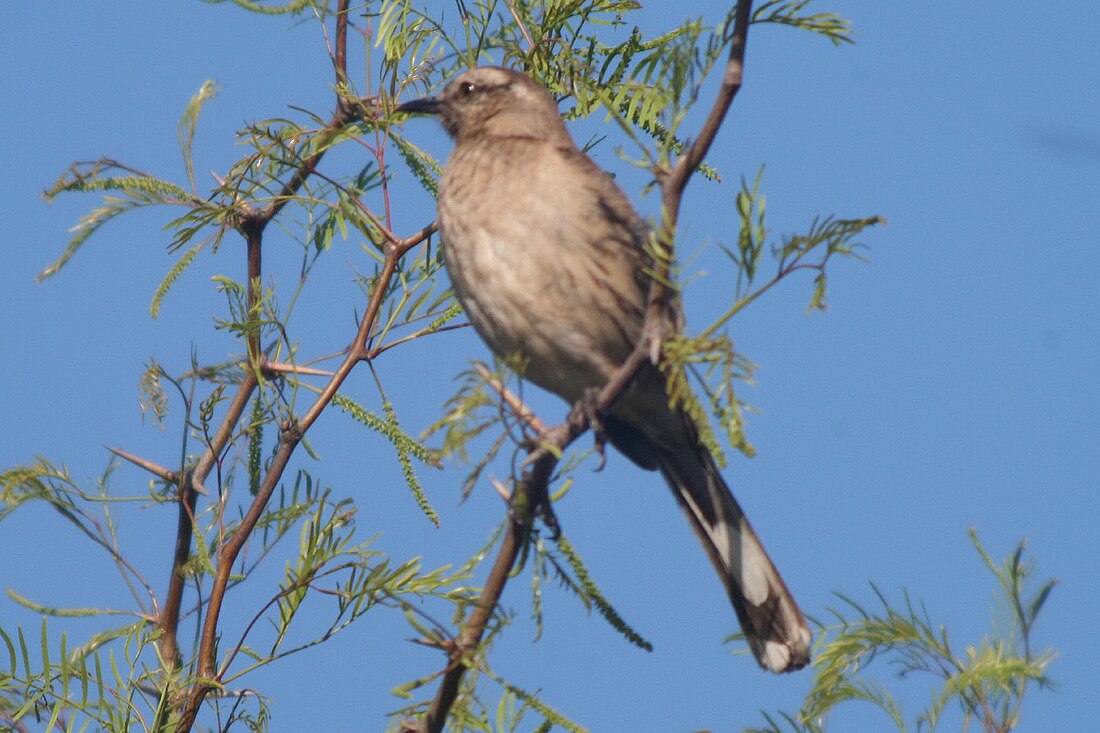Mimus
Genus of birds From Wikipedia, the free encyclopedia
Mimus is a genus of passerine birds in the family Mimidae. It contains the typical mockingbirds.
| Mimus | |
|---|---|
 | |
| Chilean mockingbird (M. thenca) | |
| Scientific classification | |
| Domain: | Eukaryota |
| Kingdom: | Animalia |
| Phylum: | Chordata |
| Class: | Aves |
| Order: | Passeriformes |
| Family: | Mimidae |
| Genus: | Mimus F. Boie, 1826 |
| Type species | |
| Turdus polyglottos Linnaeus, 1758 | |
| Species | |
|
14 recognized species, see text | |
| Synonyms | |
|
Nesomimus Ridgway, 1890 | |
Taxonomy
Summarize
Perspective
The genus Mimus was introduced in 1826 by the German zoologist Friedrich Boie to contain a single species, Turdus polyglottis Linnaeus, 1758, the northern mockingbird, which becomes the type species by monotypy.[1][2] The genus name is Latin for "mimic".[3] A molecular phylogenetic study published in 2006 found that the genus Nesomimus, containing the species endemic to the Galápagos islands, was embedded in the genus Mimus.[4] The genera were therefore merged under the earlier name, Mimus.[5] The position of the Galápagos species within the genus Mimus was confirmed by a more comprehensive study published in 2016.[6]
The genus contains 14 species:[7]
- Brown-backed mockingbird, Mimus dorsalis
- Bahama mockingbird, Mimus gundlachii
- Long-tailed mockingbird, Mimus longicaudatus
- Patagonian mockingbird, Mimus patagonicus
- Chilean mockingbird, Mimus thenca
- White-banded mockingbird, Mimus triurus
- Northern mockingbird, Mimus polyglottos
- Socorro mockingbird, Mimus graysoni
- Tropical mockingbird, Mimus gilvus
- Chalk-browed mockingbird, Mimus saturninus
The Nesomimus group includes the following species endemic to the Galápagos Islands:
- Española mockingbird, Mimus macdonaldi (formerly Hood mockingbird)
- Galápagos mockingbird, Mimus parvulus
- Floreana mockingbird or Charles mockingbird, Mimus trifasciatus
- San Cristóbal mockingbird, Mimus melanotis
The Nesomimus group is endemic to the Galápagos Islands. These mockingbirds were important in Charles Darwin's development of the theory of evolution by natural selection.
Previous to the merger between Nesomimus and Mimus scientists have proved in 1971 that both groups can produce hybrids. Robert I. Bowman and Anne Carter have studied a female Galápagos mockingbird and a male from the long-tailed mockingbird subspecies Mimus longicaudatus punensis that have interbred. They raised a hybrid offspring to adulthood.[8]
References
External links
Wikiwand - on
Seamless Wikipedia browsing. On steroids.
